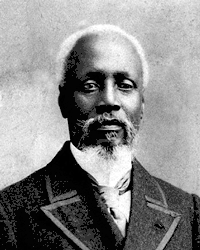Môle Saint-Nicolas affair
The Môle Saint-Nicolas affair was a diplomatic incident between Haiti and the United States that began in 1889.

.jpg)
Events
Shortly after Florvil Hyppolite assumed the presidency of Haiti in October 1889, US President Benjamin Harrison, acting under the advice of Secretary of State James G. Blaine, commissioned Rear-Admiral Bancroft Gherardi to negotiate for the acquisition of Môle Saint-Nicolas with the aim of establishing a naval station there. In an example of gunboat diplomacy, a large fleet—including over 100 guns and 2,000 men—was dispatched to Port-au-Prince with the apparent intention to intimidate the Haitians. From his flag ship, the Philadelphia, Rear-Admiral Gherardi addressed his demand for Môle Saint-Nicolas to the Haitian Government; his letter contained the additional demand that "[s]o long as the United States may be the lessee of the Môle Saint-Nicolas, the Government of Haiti will not lease or otherwise dispose of any port or harbor or other territory in its dominions, or grant any special privileges or rights of use therein to any other Power, State, or Government."[1]
Anténor Firmin, then Haitian Secretary of State for Exterior Relations, requested Gherardi's credentials. Gherardi was forced to write to Washington D.C. for them; having been confident of a swift victory, Gherardi had not attempted to secure the cooperation of Frederick Douglass, who was at that time United States Minister at Port-au-Prince. By the time President Harrison's letter appointing Gherardi his special Commissioner reached Port-au-Prince, the American squadron had long been in Haiti's waters. The array of force had been counterproductive, provoking loud public protest against the Americans. Under these circumstances, President Hyppolite was compelled to stand firm against the Americans. Firmin refused the deal on the grounds that the Constitution of Haiti forbade alienation of any portion of the nation's territory.[1]
Aftermath
Harrison and Blaine were not discouraged by their failed attempt to acquire Môle Saint-Nicolas. Still bent upon acquiring a naval station in the West Indies, they applied in 1892 to the Dominican Republic. John S. Durham, who had replaced Douglass as Minister at Port-au-Prince and Charge d'Affaires at Santo Domingo, was instructed to lease Samana Bay for a term of 99 years at a cost of $250,000. The deal ultimately was not consummated.[2]
References
- Léger, Jacques Nicolas (1907). Haiti, her history and her detractors,. New York; Washington: The Neale Pub. Co. pp. 245–247.

- Veeser, Cyrus (2005). A World Safe for Capitalism: Dollar Diplomacy and America's Rise to Global Power. Columbia University Press. pp. 35–39. ISBN 9780231500944.